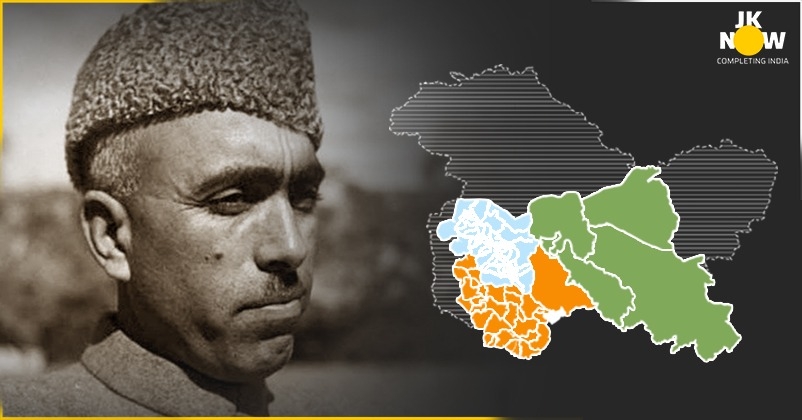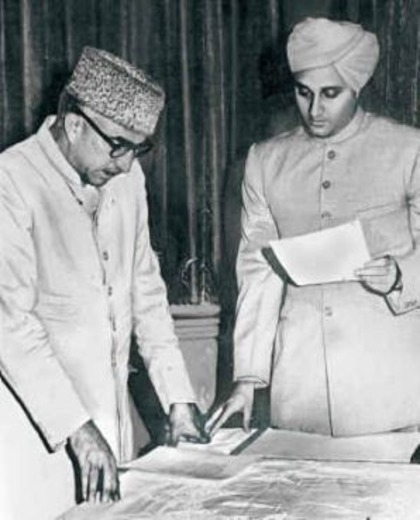Delimitation in J&K- Here are the FACTS to understand this fraudulent beginning
| 11-Jun-2019 |

Our history decides our present and the present shapes the future. In case of J&K the history of the state post 1947 has been full of deceit and fraud by the then leadership. Even delimitation for the state legislature is not an exception to this planned fraud. In this article we will discuss the faulty delimitation which changed the course of politics in the state.
According to the Administrative Report of the Government of Maharaja of J&K, total population of the state on the basis of 1941 census figures- 16-10-1940 to 15-10- 1941 was 40,21,616. The population of Jammu Province was 20,01,557, Kashmir was 17,28,686 and that of Gilgit / frontier Illakas of Skardu, Kargil & Ladakh was 3,11,915. It is a known fact that while the British ruled large territories of India directly, there were more than 550 Princely States, ruled by hereditary rulers. These Princely States were subject to paramountcy of the British Crown. In 1947, while the British India was partitioned, the princely states had to join the dominion of either India or Pakistan. The ruler of the state had the privilege to choose and join the dominion by signing the Instrument of Accession in favour of the dominion of his choice. The ruler of J&K, Maharaja Hari Singh signed the Instrument of Accession in favour of India on 26th October 1947.
Pakistan had started skirmishes in J&K from September 1947 and the final blow was on 22nd October 1947, when Pakistan army along with the Pathan Tribesmen attacked J&K. As a result of this a large number of Hindus and Sikhs had to flee the areas attacked by Pakistan. This war ended with a ceasefire because India took the matter of Pakistan aggression to the United Nations in January 1949. Although the resolution passed by the United Nations Security Council (UNSC) declared Pakistan the aggressor and asked Pakistan to vacate the occupied territories of J&K in India, Pakistan did not comply. Thus, since 1947 a huge territory of J&K is under illegal occupation of Pakistan, now known as Pak Occupied Jammu Kashmir or POJK. The hapless people who were compelled to migrate from POJK are called the Displaced Persons or the DPs.
The exodus of Hindus and Sikhs from POJK resulted in significant change in population density in the state, the occupied territories by Pakistan had Muslim population and the Hindu and Sikh population, which escaped the occupied areas, mainly took shelter in Jammu, some went to other states of India. Evidently, with the development of these events, the census of 1941 did not have much relevance and a new census was inevitable. However, Shaikh Abdullah and his interim govt thought otherwise. On 1st May 1951, Yuvraj Karan Singh, the Regent and the Head of the State, by order number 22 declared that Electoral Districts, with single member representing each district with a population of 40,000, will be formed to create the Constituent Assembly. Total number of members in the Constituent Assembly were fixed to 100, although, the basis for calculating the number of seats without counting of population is not explained anywhere!! There was no statistical basis to reach this figure and more shocking was the distribution of Electoral Districts/seats between Jammu, Kashmir, Ladakh and POJK. 25 Electoral Districts were reserved for the areas illegally occupied by Pakistan ie POJK. Of the remaining 75 Electoral Districts/seats, 43 seats were assigned to Kashmir Region, only 30 for Jammu Region and two Electoral districts for Ladakh Region (one each for Leh and Kargil). This was the arrangement by the Interim Local Government of J&K with Sheikh Abdullah as the Prime Minister.

Sadar-i-Riyasat Karan Singh administers the oath of office to Bakshi Ghulam Mohammed after the 1957 elections in Jammu and Kashmir.
The delimitation of Electoral Districts on the basis of Single Member Constituent Assembly, in 1951 was done in haste and without any logical or statistical consideration, but certainly with ulterior motives. One can only assume that it was decided on the basis of 40 Lakh population as counted in 1941, with 40,000 people for each Electoral District, arriving at the figure of total 100 Member in the Constituent Assembly. The basis to put aside 25 seats for POJK is not known. It seems that Shaikh Abdullah randomly assumed that 10,00,000 people have been left out in the POJK and hence 25 seats were assigned to POJK. It is pertinent to note here that Shaikh Abdullah also assumed that larger population of Jammu was in POJK, or else he would not give less seats to Jammu, which even after illegal occupation by Pak was larger than Kashmir in area and had larger population as per the 1941 census.
Let us do the simple calculation to understand the fraud of Shaikh Abdullah. As per the Website of J&K Raj Bhawan (10-04-2013) the total area of the State is 2,22,236 sq. kms including 78,114sq. kms under the illegal occupation of Pakistan and 42, 685 sq. kms under that of China. The area under illegal occupation of Pakistan i.e Mirpur /Muzaffrabad etc is 13,297 sq km, Gilgit/ Baltistan is 72,496 sq km. As per Planning Commission, GOI Report, chapter -VI page 336, the area occupied by China in 1962 war is 37,555 sq km and control of another 5,180 sq km of areas from illegally occupied areas by Pakistan- POJK, was given by Pakistan to China in 1963 (this has also been confirmed by GOI in reply to Raj ay Sabha Question No: 367, asked by Chandra Mitra on 15- 03-2012).
Thus, area under China and Pakistan is about 1,20,849 sq. km. Of the remaining 1,01,387 Sq. km which is the current J&K state, the largest part of the State is Ladakh with 59,000 sq. km, the second largest area is of Jammu with 27,000 sq. km and the smallest part is Kashmir with 15000 sq-km.
Despite such a large-scale shuffling of population, there was no census conducted in 1951. The seats allotted by Shaikh Abdullah, were 43 to Kashmir, 30 to Jammu and 2 to Ladakh. The proportions of 43:30:2 could be fixed only if out of 30,00,000 population 80,000 was in Ladakh Region, 12,00,000 in Jammu Region and 17,20,000 in Kashmir Region. This is not practical assumption and is far from reality,because as per the census of 1941 the total population of J&K was 40,21,616. Jammu Province had largest population ie 20,01,557, Kashmir had 17,28,686 and Gilgit / frontier Illakas of Skardu, Kargil & Ladakh had a population of 3,11,915.
Even if one considers that large population was left in POJK, the victims of mass exodus, Hindus and Sikhs, who escaped the massacre, had settled in Jammu, thus adding to the population of Jammu and not to that of Kashmir. It is significant to note here that the territories and Muslim population of Kashmir region also was lost to the illegal occupation of Pakistan. But, as per the cunning calculations of Shaikh Abdullah, Kashmir had not lost any population, whereas Jammu had lost considerable population and hence more seats were allotted to Kashmir in comparison to Jammu. Nothing justifies the difference of 13 seats between Jammu and Kashmir, because Kashmir, with smaller area and population was given 13 seats more than Jammu, which was larger in territory and population size. The blatant biased and discriminatory division of seats should have alarmed the central leadership. But they remained oblivion to this treacherous game of Shaikh Abdullah. It is a pity that even Yuvraj Karan Singh, the Regent remined a mute spectator to this blatant and deliberate discrimination, favouring Muslim dominant Kashmir, against Hindu dominant Jammu.
The other important point that needs to be considered is that before October 1947 the Jammu Region comprised of five districts, namely Jammu, Kathua, Udhampur, Reasi and Mirpur and two Jagirs, Poonchh and Chenani, of these Poonchh was as big as a district. Kashmir region, on the other hand, comprised of only three districts, namely Anantnag, Baramulla and Muzaffrabad. The Jammu Region had 17 Tehsils and two Jagirs whereas Kashmir region had only l0 tehsils. This is a proof that whichever way one calculates, Jammu was the bigger region in area and population compared to Kashmir. Ladakh Region had very large territory but very scattered and scanty population. After the attack, the district of Mirpur and few villages of Poonch Jagir from Jammu Region were illegally occupied by Pakistan. Despite this, four Districts ie Jammu, Kathua, Udhampur and Reasi and two Jagirs were intact in Jammu to form the Electoral Districts. From Kashmir Region, Pakistan illegally occupied the district of Muzaffrabad and few border villages of Baramulla district, thus only two districts ie Anantnag and Baramulla were remaining in the Kashmir region. But the then Delimitation Committee appointed by Sheikh Abdullah administration allocated only 30 Electoral Districts out of 75 to Jammu Region whereas 43 Electoral Districts were allocated to Kashmir Region.
As mentioned above, there was mass displacement from areas, which were illegally occupied by Pakistan from district of Mirpur and Muzaffrabad in Oct 1947 and almost all the displaced persons settled outside Kashmir valley, majority of them settled in Jammu Region.
The disturbing fact is that the hasty, discriminatory and biased division for the Constituent Assembly done by Shaikh Abdullah in 1951, was carried on and instead of correcting the unjust distribution, it was, further cemented and authenticated by continuing with the same distribution of seats for the Legislative Assembly of the state. By this faulty distribution of seats, Shaikh Abdullah and his party ensured the hegemony of Kashmir in the politics of J&K. This was exactly opposite of the spirit of the constitution of the state, which made provisions for fairness and justice. Currently, there are total 111 seats in J&K Legislative Assembly, including the seats of POJK. Of the 111 seats, 24 are reserved for POJK, despite appointing the Delimitation Commissions, Kashmir has 46 seats, where as Jammu is allotted 37 seats and 4 eats are allotted to Ladakh. Almost seven decades have passed, the people of Jammu have been bearing the brunt of this injustice.
How can a state progress and flourish if the very foundation of the state is based on falsehood, deceit and dishonesty?? The unscrupulous plans of Shaikh Abdullah and National Conference, set the trend of shameless biases. The distribution of seats is the conspicuous proof of this trend of separatist and discriminatory politics. The dishonesty of the past has decided the troubled and distressed present, but now corrections based on justice and fairness are obligatory to ensure a better future for the coming generations of J&K.